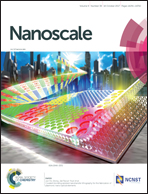A paper triboelectric nanogenerator for self-powered electronic systems†
Abstract
Paper, as one of the most important inventions of mankind, is still widely used in our daily life. In this study, the paper is explored as a platform for power sources based on the universally known triboelectric friction. A novel paper triboelectric nanogenerator (P-TENG) was successfully developed, which could harvest mechanical energy from ambient sources and generate considerable electrical energy. The maximum power density of the P-TENG reached 53 W m−2. In addition, the P-TENG possesses a natural advantage of being able to be integrated within a book, and thus can effectively convert mechanical energy from the action of turning book pages into electricity. When turning a book page, the output voltage and current of the P-TENG were obtained to be about 400 V and 0.17 mA, respectively. This generated electricity could directly light up 80 commercial white light-emitting diodes (LEDs) connected in series without any energy storage process. The white LEDs powered by the P-TENG can provide sufficient illumination for reading printed text in darkness. This research provides a promising solution for developing paper-based self-powered electronic systems.



 Please wait while we load your content...
Please wait while we load your content...